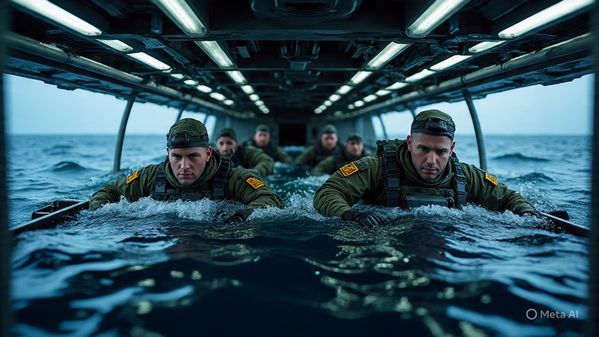
🛡️ Navy SEALs Submarine Training in the Pacific: Inside America’s Deepest Military Secrets
Navy SEALs Submarine Training Pacific Deep beneath the Pacific’s rolling waves, far from sight and sound, the U.S. Navy SEALs prepare for missions that may never be acknowledged. It’s not just training. It’s underwater warfare mastery—practiced in complete darkness, in some of the world’s most unforgiving environments.
From silent entries through submerged hatches to hours inside a steel shell under crushing water pressure, Navy SEAL submarine training in the Pacific is one of the most elite and secretive military operations conducted by the U.S. Special Operations Command (SOCOM). In this post, we’ll dive into what really happens when America’s most elite warriors go below the surface—literally.
🌊 Why Train Underwater? The Strategic Role of Submarines in SEAL Operations
Navy SEALs (short for Sea, Air, and Land) are trained to operate in any environment—but the underwater domain is especially critical to their core mission: covert insertion and reconnaissance behind enemy lines.
Submarines offer:
-
Stealth access to hostile or denied territory
-
Launch points for underwater missions using mini-submersibles or swimmer delivery systems
-
Operational security — they’re virtually invisible on radar or satellite
The Pacific Ocean, with its vastness and depth, serves as the perfect backdrop for these classified operations. Training here ensures SEALs are prepared for real-life missions in regions like the South China Sea, Philippine archipelago, or Korean peninsula—where water-based infiltration is often the only option.
🧭 Inside the Training: What SEAL Submarine Missions Actually Involve
🔐 Step 1: Embedding with a Submarine Crew
SEALs begin by boarding a host submarine, usually a Los Angeles or Virginia-class attack sub, which has been specially modified to house Dry Deck Shelters (DDS). These are airlocks that allow SEALs to exit the submarine while submerged.
🚨 Note: These shelters are so secretive that even some Navy personnel are unaware of their full capabilities.
🐋 Step 2: Deployment via SEAL Delivery Vehicle (SDV)
The SEALs enter a mini-submersible called the SEAL Delivery Vehicle (SDV). These battery-powered craft carry 6–8 SEALs, fully armed, in freezing cold water, often for several hours. SDVs are launched while the submarine remains 60 to 100 feet below the surface.
Inside the SDV:
-
No heat.
-
No lights.
-
SEALs are submerged the entire time, breathing through closed-circuit oxygen systems.
They train to:
-
Navigate in zero visibility
-
Communicate silently
-
Execute missions like placing limpet mines or gathering surveillance data
“It’s like driving a car blindfolded at night with no windshield, underwater,” said one former SEAL during a public interview in a documentary series.
📍 Training Locations in the Pacific
Although precise locations are classified, known and speculated training grounds include:
-
Naval Special Warfare Command, Coronado, California
-
Joint Base Pearl Harbor-Hickam, Hawaii
-
Guam and the Mariana Trench region
-
San Clemente Island Undersea Training Range
-
Puget Sound Naval Complex, Washington
These sites offer:
-
Realistic ocean floor terrains
-
Submarine-compatible ports
-
Classified testing zones for deep-water infiltration exercises
🧠 Mind Over Muscle: The Psychological Challenge
Submarine-based SEAL training is not just about strength—it’s about control, silence, and trust.
-
Claustrophobia is real. A SEAL might spend 6+ hours in a flooded SDV compartment, arms pressed to their sides.
-
No visibility. Ocean silt and darkness reduce vision to zero.
-
Mental fortitude. You’re cold, cramped, and responsible for a $3M mission.
This isn’t boot camp yelling and running. It’s hyper-focused, slow-burn stress—testing decision-making under pressure. Only the most mentally resilient operators make it through.
🛠️ Tools of the Trade: SDVs, DDS, and Beyond
| Equipment | Description |
|---|---|
| SEAL Delivery Vehicle (SDV) | Manned mini-submarine; stealth insertion below the surface |
| Dry Deck Shelter (DDS) | Underwater lockout chamber fitted to submarines |
| Diver Propulsion Device (DPD) | Smaller handheld device for faster swimming in shorter missions |
| Rebreathers | Closed-circuit breathing systems—no bubbles, no detection |
| Hydrographic Recon Kits | Sonar and mapping gear for covert shoreline surveying |
🛡️ How Submarine Ops Fit into U.S. Military Strategy in the Indo-Pacific
The Indo-Pacific is the most contested maritime region on the planet. With tensions between the U.S., China, North Korea, and others, SEAL underwater operations are a silent weapon in America’s defense toolkit.
Strategic advantages include:
-
Access to island chains without detection
-
Shoreline reconnaissance before Marine landings
-
Sabotage of enemy underwater assets
-
Countermine or rescue operations
In a potential future conflict scenario—say, Taiwan or the South China Sea—submarine-inserted SEAL teams may play a critical first-strike or intelligence-gathering role.
🕵️ Why So Much Secrecy?
Unlike SEAL jump training or urban warfare exercises, submarine missions are rarely publicized.
Why?
-
They often relate to ongoing or future classified ops
-
Training overlaps with covert CIA or international joint operations
-
Failure could result in international incidents
This extreme secrecy also preserves tactical advantage—if no one knows what’s possible, the enemy can’t defend against it.
📺 Public Glimpses: What We Do Know
-
The “Silent Option” documentary series (available on select military platforms) has covered limited submarine training glimpses.
-
Retired SEALs like Jocko Willink and David Rutherford have hinted at underwater missions in interviews.
-
The Navy has acknowledged the existence of SDV Team 1 (based in Pearl Harbor) and SDV Team 2 (East Coast).
Still, most operations remain in the shadows.
✅ Key Takeaways
-
Navy SEALs submarine training in the Pacific is among the most elite, dangerous, and secretive aspects of modern warfare.
-
It involves extreme underwater endurance, mental resilience, and cutting-edge gear like SDVs and DDS modules.
-
This training prepares SEALs for critical Indo-Pacific missions, from sabotage to reconnaissance.
-
Due to national security, much of this world remains hidden—but it’s very real and mission-critical.
❓FAQs: Navy SEAL Submarine Training
📌 Do Navy SEALs actually live inside submarines?
They don’t “live” in submarines permanently but embed for specific missions or extended training ops.
📌 How long is submarine-based SEAL training?
The underwater infiltration portion can take weeks to months, depending on the SEAL’s designation and mission requirements.
📌 Are SEAL submarine missions always underwater?
Yes—most involve fully submerged lockouts, stealth insertion via SDV, or nighttime surface swim after underwater transport.
📌 Where are SEAL submarine teams based?
The U.S. has two SDV teams:
-
Team One: Pearl Harbor, Hawaii
-
Team Two: Little Creek, Virginia
🧭 Final Word
In an age of cyber threats and drone warfare, it’s easy to forget the physical, grueling reality of special operations. Yet while satellites scan the skies, the Navy SEALs quietly slip beneath the waves—training in the deep Pacific, preparing for wars that may never be seen, but must always be won.
Their domain is silent. Their missions are unseen. But their impact? Unmistakable.






